|
|
As a side effect of planning forward for my next trip to Las Vegas, I’ve actually found myself staring at a summary of my entire live poker career so far.
As I’d decided to start using the iPhone app Poker Journal to record all my sessions from now on, it made sense to try to import all my old data into the same application before I got started.
That way I’d already have some lovely graphs to look at.
Although it’s not a documented feature of Poker Journal, it’s possible to use the backup and restore facility to import data from another source. In my case, I had a master spreadsheet that I’d built up over the past few years from all the mobile phone spreadsheets I’d been keeping on my travels.
To be honest, that spreadsheet didn’t do much. I’d set it to calculate a total profit/loss and done some (frankly) bodgetastic jiggery-pokery to give totals per trip and to add up limit hold’em and no-limit hold’em profit and loss separately. With a bit of effort I managed to get a graph out of it once.
I’d been in contact with the developer, Michael Golden, who had already drafted a document that explained the data format he used and because my spreadsheet was so simple it wasn’t too much of a problem to convert it. If anyone is in a similar situation, the script I wrote to process my own data might be of some use to you. Leave me a message.
So, what does this wonderful little app do? Let’s start with what matters – a graph, of course!
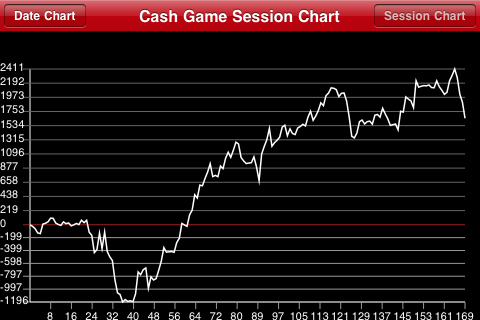
This is my cash game history for every session I’ve played in Las Vegas since 2006. I was a relative latecomer to The Cash. Thinking back, I probably I played a couple of sessions of $2/$4 in the summer of 2005 (my first month-long Vegas expedition, pre-blog) but not enough to make a difference.
I definitely didn’t touch no-limit hold’em until Summer 2006, and even then it was only briefly, scared away after the first attempt by the nine rocks I found myself surrounded by at Sunset Station. In retrospect, this was horrible game selection (based only upon which casino was close to where I was staying at the time) which probably set me back more than I realised.
You’ll see from the graph that after the minimal variance of $2/$4 limit hold’em, it took me a little while to find my feet with no-limit, and I had a 6 buy-in downswing (I almost always buy in for $200) before the climb back started.
Poker Journal does a bit more than draw pretty graphs too. There’s plenty of fascinating statistics. The ones below are filtered just for no-limit hold’em:
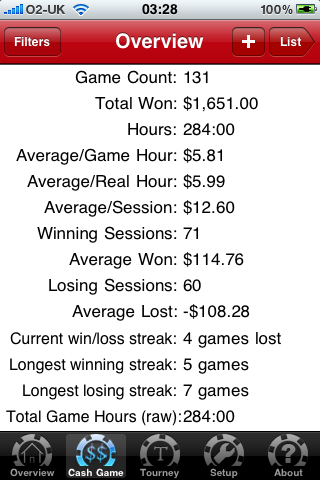
Hardly an hourly rate I can “go pro” with, but it’s in the black at least.
If I switch to “glass half full mode” the 71-60 winning record isn’t awful – and in reality, winning more sessions than you lose isn’t even important. What matters is winning more actual money the times you win than you lose the times you get sucked out on by some idiot douchebag who loves playing queen-three.
Not a bad beat story, I just made up a garbage hand at random. I promise.
With that 11 game differential, I managed to turn a profit of just over 8 buy-ins, which is a fairly reassuring way to look at it.
If only I could have “average luck”, surely that number would go up, right? …
But is 284 hours enough to draw any reliable conclusions from? No, not really.
My career graph currently ends on a bit of a downer – which reflects how my poker results went towards the end of the summer trip. Suddenly, I just stopped being able to win pots.
Whether I ran particularly badly or if it’s just variance, who knows. Maybe I am a $6/hr player (or worse) and it was about time for this to happen. I knew everything had turned to shit at the time and there wasn’t much I could do except to keep turning up and hope to catch a break before I had to catch a plane. I never did.
Boy am I ready for a re-match. Three days to go… 🙂
I didn’t get in half as many hands this month on iPoker, mostly because I spent most of my online poker time playing turbo sit-and-gos on Poker Stars in order to clear a bonus that was about to expire.
I had less than stellar results at both sites, but I guess I can’t complain that despite losses at the tables, they both gave me net wins on the month:
Stars: Lost $189 to release $240 bonus and redeemed 10,000 FPPs for $160. I was about half way towards both the bonus and the redemption award at the start of the month so I’ll count this as earning $200 of bonus and cashback. Net: +$11.
iPoker: Lost $102, released $90 bonus, received $68 rakeback. Net: +$56
I have to say, though, it certainly doesn’t feel like a winning month.
It wouldn’t be the same without a graph, would it?
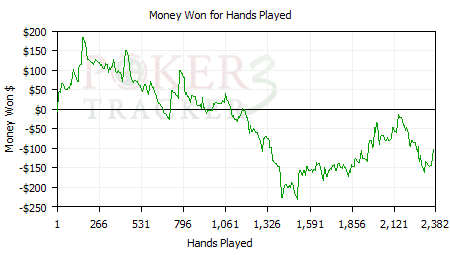
A quick summary of my poker results for May, if you’ll allow me to indulge. Shall we let the graph speak?
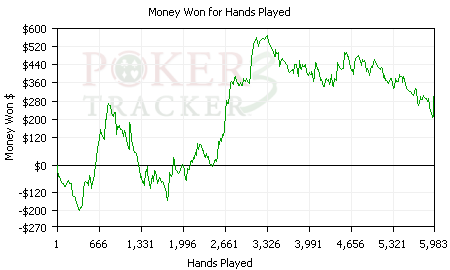
What on earth is that meant to tell me? I started off poorly, then had an awesome recovery followed by a massive tilt-off, then ran hotter then fire and gradually dribbled money away for the second half of the month.
In case you didn’t bother to count it, there’s a swing of $700 in less than 2,000 hands. Variance is a bitch.
One thing I do know is that I had better luck at $3/$6 than I did at $2/4, which has to be a significant part of the reason for the net win.

I hardly even touched no limit this month. The loss was mostly down to one big hand where I flopped a nut flush draw with an inside straight draw and there were three all-ins in front of me. I’d quite like to have run that one twice like on TV but what can you do?
Are these numbers good? Who knows… but it’s better than a breakeven month, which is all I need to make money.
In addition to the $304 win, I cleared $250 of bonus and received $169 of straight rakeback. The 25,000 points I earned are worth roughly another $50 when you spend them on stuff and sell that stuff straight away on ebay. I also won $50 in the VIP freeroll. So overall, $519 back from the $670.80 I paid in rake, which is equivalent to 76% rackback. I still love this deal!
So not a bad month at all really I guess 🙂
Gala’s weekly casino bonuses are still going strong. I’ve now played their free £10 on roulette three times, and £10 for blackjack the same.
I also checked out their Three Card Poker game when I received an email alerting me to a £10 bonus for £100 in action. That’s half as much as you need to play on Blackjack or Roulette, and while you’d except the house edge to be higher on that kind of carnival game it would have to be higher than 10% to make this bonus a dud.
There are other weekly bonuses I’ve not participated in for slots and a scratchcard game, because there’s a very good chance that these do pay back less than 90%, and there’s just no way of knowing for sure.
However The Wizard of Odds clocks Gala’s Three Card Poker paytable at a very playable 3.7% for the main bet (the perfect strategy is ridiculously easy: bet if you have Q64 or better, otherwise fold) and 2.32% on the “Pair Plus” prop bet. I played them both, and I’m glad I took the side bet because I hit a super hot streak of straights (each paying 6-1) to give me a total profit of £36, plus the £10 donation from Gala for showing up.
I must have been owed something good though after a brutal blackjack session earlier in the week which cost me £30. That’s after offsetting the free £10, so it was a pretty severe £40 loss from 200 hands, playing £1 per hand. The effect of the bonus money makes it twice as easy to win £30 (as I did the first time I played) than to lose £30.
While the expectation of these quickie bonuses is good, the swings can be wild. Fortunately, with so many of them to play (now at least 3 per week that I know are profitable), things should start to even out fairly quickly.
Here’s the story so far. I am working on a house edge of 1% for blackjack, 1.35% for European roulette on even money bets only (but 2.7% the first week, when I didn’t know about this rule) and 3.7% for Three Card Poker.
| Date |
Game |
Expected |
Actual |
| 1-May |
Blackjack |
8.00 |
32.50 |
| 2-May |
Euro Roulette |
5.60 |
8.00 |
| 8-May |
Blackjack |
8.00 |
-30.00 |
| 9-May |
Euro Roulette |
7.30 |
3.00 |
| 11-May |
Three Card Poker |
6.30 |
46.00 |
| 15-May |
Blackjack |
8.00 |
-3.50 |
| 16-May |
Euro Roulette |
7.30 |
-7.00 |
| |
TOTAL |
50.50 |
49.00 |
Not too far off then. Keep ’em coming!
I’ve never played casino roulette before to release a bonus. There was a juicy risk-free play on Sporting Index’s roulette spread game for a while, but for down-and-dirty bonus whoring the house edge on roulette is usually too high to make it worthwhile.
However, I just found a weekly promotion from Gala Casinos that turns roulette into a theoretical winner. It’s only a £10 bonus, and with a £200 play requirement you should expect to lose just over half of that (figuring a single-zero wheel with 2.7% house edge; forget about it with double-zero) but you can play it every Saturday, and you don’t need to keep depositing and withdrawing. You can just transfer funds between casino and sports to activate the bonus code.
There’s also a blackjack bonus every Friday (£10 free for £200 in action, worth at least £8 per week) and a bunch of other random bonuses which may or may not be worth taking advantage of.
Look after those small edges and the bankroll will look after itself.
I did activate another bonus for blackjack last week. However it could only be played at their live dealer casino and once I saw what was involved I gave up pretty quickly.
Don’t get me wrong., if you want to chill out and play some cards online it’s probably great. The concept actually works really well. The video and sound quality is fine, and the cards have jumbo numbers on so you can see exactly what has been dealt for yourself. Plus, because you can see a human shuffling and dealing the cards, you can be confident that the game is fair.
Furthermore, if you were so inclined, you could count cards extremely easily. Use a pen and paper if you want – nobody is watching. You could even play the spotter and call in a friend as the big player to avoid detection (see the movie "21" or any of dozens of documentaries about the MIT teams for how this works).
However, if you just need to grind through 125 hands at the table minimum to clear a £25 bonus (which, relative to the amounts at stake, is much more profitable than card-counting) it’s going to take hours.
Clearly computerised gambling is going to be quicker than anything that is run by a human, but live over-the-internet gambling is much slower still. A dealer in a casino usually doesn’t ask if you want to stand on 20, give a long speech and wait 30 seconds when offering insurance against an exposed ace, or announce the name of each winner after every hand. I found these delays pretty painful.
Back to the roulette. It really wasn’t much effort to play through £200 for my few quid of expected value while I was cranking up a few poker tables. It took about ten minutes.
The quickest and lowest-variance way, I figured, would be to bet £99 on red, £99 on black and £5.50 on zero. It works out very nicely with 50p chips in play: for a £203.50 total stake (instantly releasing the £10 bonus) you’d always get back £198 for a guaranteed loss of £5.50, netting you £4.50 profit.
I actually went for a slightly different approach, hoping to avoid instant detection as a bonus abuser. My deception wouldn’t stand up to any kind of scrutiny if a real person examined my play, but at least I wasn’t betting on the both sides of the same coin flip, which would surely raise a red flag.
I placed seven £1 outside bets: red, even, 1-18, 1st dozen (1-12), 2nd dozen (13-24), 1st column (1, 4, 7, ..) and 2nd column (2, 5, 8, …).
This combination meant that although I covered almost every number on the layout – and most of them at least once – it was still gambling. I’d lose everything on a zero or black 33.
Or so I thought. To meet the £200 play requirement, I had to spin the wheel with this £7 bet 28 times (plus a slightly smaller bet to make up the difference) so the odds of hitting a wipeout number were high. Eventually a zero came – and with it an unexpected lesson in European roulette rules.
I was amazed to see £1.50 returned to me from what I thought was a completely losing bet. Turns out that you actualy get half back on the even money bets when a zero is spun.
Shows how much I know about roulette, I’ve never heard of that before. I don’t know how widespread this in in European casinos (Wizard of Odds has some information about this, and some variations) but I know Ashley Revell wasn’t going to get half his life savings back if a zero came.
This is fantastic news. The rule reduces the house edge on even money bets from 2.7% to 1.35% and increases the value of this bonus from £4.60 to £7.30 – assuming that you only make even money bets. Which, of course, I did from that point on.
It’s also opened my eyes to the possibility of exploiting roulette bonuses at other online casinos that offer the same rules. It’s still going to be tough to find a beatable game with a 1.35% house edge, but it’s twice as feasible as I thought it was.
For what it’s worth, I made £8 today. It’s not really worth getting excited about, but with several small bonuses available at the moment, my money is working harder for me in the Bank of Gala than any bank I can think of.
It’s awesome to break even.
I’m serious. I mentioned this before – if I can hold my own and not lose any money at the table on the iPoker network, I can make money over the course of the month from bonus awards and rakeback.
I could only be happier with how my bumpy ride through April ended if I thought I was good enough to actually win money in these games.
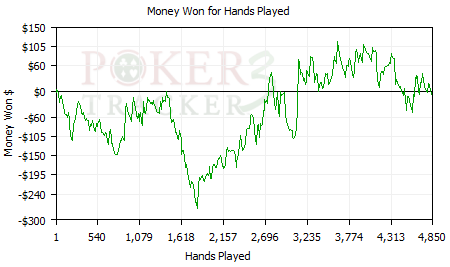
Never mind the variance (it’s a $400 swing from the lowest to highest point) – I lost 93 cents. How much closer to breaking even could I possibly get?
When you add everything up, this puts me up over $400 on the month; $170 in bonus already released, $115 in rakeback to come, a $100 win from a VIP freeroll in the bank and enough player points earned to put me a quarter of the way to redeeming for another iPod nano (figure it’s worth about $30; I got £90 for the last one on eBay).
The freeroll is a $2,000 prize pool, usually with about 100 runners making it worth about $20 per week. It’s the first time I’ve made the money, and I wasn’t sure whether to count it in my monthly haul but as the amount I won is about the same as the EV of playing in it every week I figured I probably should.
I was an overall loser on fixed-limit games but an overall winner on no-limit – but somehow the two numbers cancelled each other out almost exactly.

That 6.76% of hands won figure on $2/$4 is a bit worrying. Yes, I play tight. No, I wouldn’t expect to win 10% of hands in a full-ring game (I’d hope to win larger than average pots to offset this). But I need to work out whether I’ve just had some bad luck, or if I’ve been giving up pots too easily.
A bit more analysis on Poker Tracker also shows that when you total up all the hands that I called a raise on the big blind, I lost more money than I would have done if I’d simply folded every one of them. I’m profitable when I re-raise (thankfully – it’s almost always with premium cards!) but I need to take more care when it costs an extra small bet to play mediocre cards out-of-position. I’m happy to have found the leak so that I can try to do something about it.
However it’s a reassuring start to the first month that I’ve played no-limit on iPoker for anything more than a few short sessions. The sample size is still pretty insignificant, but the row is green and that’s about as much as I could ask for.
Let’s see if I can’t win a few cents this month.
Here’s an impressive looking graph from my limit hold’em play last month.
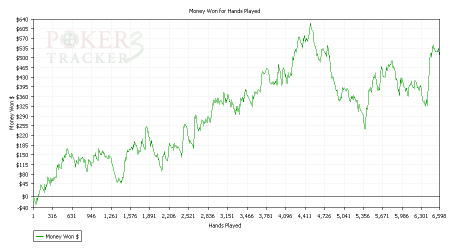
Sadly, it only tells half the story. I really needed that big upswing to get back even.
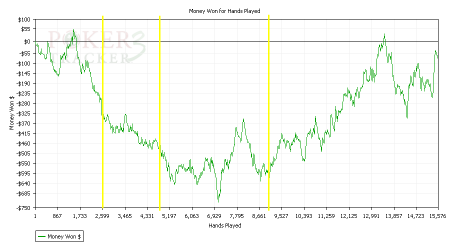
The yellow lines on this graph show the end of each month that I’ve been playing $2/$4 and $3/$6 on the iPoker network.
Things did not start well, so "about even" is not only a good result relative to how I’d begun, but it also seems to be a very good result in this game. The tables are overrun by rock-tight bonus-grinders, many of whom play little more than 10% of the hands they’re dealt.
As that’s exactly what I’ve been trying to do, it would be hypocritical to call them nits. Hyponitical, perhaps.
I have to assume that the regulars I see all the time and assume to be professionals are all well-compensated for their efforts because among the familiar names – all of whom are all logging tens of thousands of hands every month – almost nobody is actually making money at the tables.
For me, the extra money I get is 25% rakeback and a $10 bonus for every 1,000 player points. So while Poker Tracker says that I’m about even, my balance says that I’m actually $766 up from where I started.
I’m also getting close to being able to cash in my player points for an ipod nano. I don’t want it, but their store has a fairly limited selection and it’ll sell on ebay. Call it another $100 in added value, because I should get there in a week or so.
So in total that’s $866, and Poker Tracker tells me that I’ve paid $1460 in rake over nearly 16,000 hands. Overall, that’s equivalent to nearly 60% rakeback, which ain’t bad at all. I’d get a slightly better deal if I played more, too.
With this level of payback, you could sustain a loss rate of 1 big bet per 100 hands and still break even (the actual figure is -$5.41 per hundred, based on my data at $2/$4 and $3/$6). So if you are able to lose money no quicker than that, there’s a clear profit potential from playing poker under these conditions.
Until recently, I was losing a little faster than that: 1.25BB/100.
So, given my sudden change in fortune this month, is is possible that I suddenly started doing something right?
I really can’t say for sure, it’s much too early to know whether I’m simply on a nice long hot streak. I’m still finding it hard to believe that I have actually won it all back, and given that I can’t recall seeing more than two long-term winning players in this game the whole time I’ve played it, I’m a long way away from even thinking that I could be the third.
But I did make one change to the way I played this game, which was to adhere to strict criteria about not only which tables I played at, but also the seat I sat in.
In fact my rule is pretty crude: A player makes my buddy list by playing more than 30% of hands, and if I can’t sit within two seats to the left of a buddy, I don’t sit down.
30% of hands might not sound excessively loose, but the typical range for strong players in this game is more like 15% so looking for anyone playing at twice as many hands as this, and then making sure I had position on them for the majority of the hands I would play, seemed like a good place to start.
That’s it. I hoped that improving my game selection would help me lose less quickly so that I could grind out a little profit from bonuses and rakeback. If it can actually turn me into a winning player, that would be simply stunning.
It could all turn around again this month though. Watch this space, graph fans…
I’ve given up at the $27s, at least for a while.
I’m on an absolutely horrible downswing, and for as much as I genuinely think I’m running abnormally poorly I’m just not confident enough that it’s the only reason I’m leaking money at hyperspeed. So, I’m going to drop back down for a while and try to win enough to take another shot.
It’s pretty difficult to draw any conclusions from what’s happened this month because I really didn’t get to play enough tournaments to find any reliable trends, even though (sadly) the recent downward trend in my bankroll is pretty clear.
I can believe that I might not have enough of an edge to beat the rake at this level – or even any edge at all over the field – but I simply can’t believe the later stages of this trainwreck graph could be representative of my long-term loss rate.
I still thought it would be worth trying to correlate my luck against my results, using a refined version of the technique I developed earlier in the week. The graph below runs from the start of October until last night.
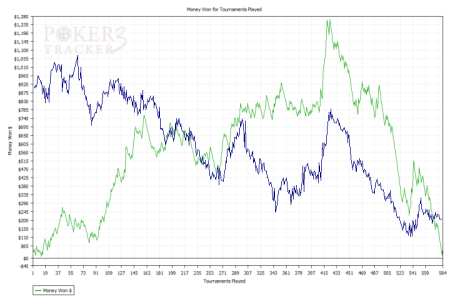
The green line shows profit over time and was generated by PokerTracker as normal. Then I used a pretty crude copy and paste to superimpose the blue line for my homebrewed luck factor, which I had further mangled to only generate a point on the graph on the very last hand I played in each tournament.
There’s no particular scale for the blue line on the y-axis, and it’s not a perfect match but it lines up fairly well.
Most of the sharp ups and downs are visible on both lines and overall I’d say that about half the time the movement of the two lines seems to be in harmony, but of course this isn’t always the case. However, while I rarely had losing streaks during spells of good luck I did have some winning streaks during spells of bad luck.
If I had to suggest a hypothesis based on these graphs, I’d say that when playing the $16s luck did affect my results but at times I was able to overcome bad luck and still win anyway. On the other hand, once I moved up to the $27s (just before the sharp upswing on both lines) my good and bad luck has been the predominant influence on my actual results. In other words, my ability played a more significant role at the lower levels.
In other words, there’s definitely a chance that I’m getting pwned at the $27s.
However it is only a very small sample and, unfortunately, gathering more data could be pretty expensive.
What type of graph is this? I have no idea.
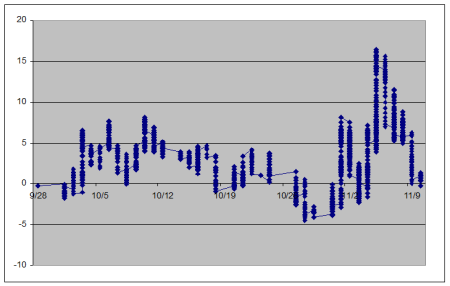
I asked Excel for a line graph, but it looks like it doesn’t want to play ball, even though the x-axis data definitely is taken from continuous dates and times, with values to the nearest second.
I guess it’ll do. It’s not like I’m going to ask the bloody paperclip what went wrong.
This is the output from my messing about with my PokerTracker database in order to try to quantify how lucky or unlucky I’ve been lately.
Since moving up a limit in the turbo sit-and-gos my results have streaked all over the place. I started off with a $500 upswing which came from results that were almost good enough to put me on the Battle of the Planets leaderboard – but not quite.
This excellent run was immediately followed by a $1000 downswing. It all happened very quickly, without me (knowingly) changing the way I played or the way I picked games.
There’s actually very little game selection you can do when a sit-and-go fills up in less than a minute and seating is randomised, but as a rule of thumb if I see a dozen tables in the lobby all with the same 4 or 5 players sitting at them the chances are those players all know what they’re doing so I’ll hang back a few minutes and wait for their games to start before I try some new tables.
I thought I was used to the ups and downs of playing turbo tournaments, but these swings seemed unusually big – and not just because of the higher stakes involved. That $1000 loss on the $27s is equivalent to about $600 on the $16s, and the worst spell I’ve ever had has been a $400 loss before starting to claw it back.
In fact, it’s only because the results were so drastic that I suspected I’d been unusually unfortunate and wasn’t just getting crushed by other players in this game.
I’m not going to get complacent. When you seem to be constantly finishing just outside the money, or only make 3rd place the times you do get there, or clock up more last place results than you’ve had in a long time there’s a good chance there’s some other reason for the bad results than just luck.
However 14 straight sit-and-gos without finishing in the money is a clear personal worst. An actual monkey should get better results than that, as long as he thumps on the mouse often enough not to get timed out.
My dilemma was that I wanted to stick with it and ride out the bad streak but unless I could somehow show myself that I was statistically running bad (and therefore stood a chance of holding my own with "average luck") I was going to have to move back down.
I generated the graph above by pulling out of PokerTracker all the hands where I was all-in pre-flop, either raising first and getting called or calling someone else’s push. In turbo tournaments the blinds get big quickly, so you have to take flips like this a lot.
The query I wrote only looked at hands with two players at showdown (about 6% of my all-ins were 3-way or worse) and ignored split pots. There seems to be a quirk in the PokerTracker database when one player is forced all in on a blind so that it doesn’t know whether he "won" or not (it treats the small stack surviving and the big stack losing less than a big blind as a split pot) so I excluded those hands too (another 5% of my hands).
From this I plugged each hand in turn into poker-eval, grabbed my equity value and used this to plot a cumulative graph of my performance ahead of or behind expectation.
This is a similar concept to Sklansky bucks, but I treated every all-in situation as having the same unit value rather than counting how much money was at stake each time. Converting the amount of tournament chips won or lost on each hand to an amount of real money would just be way too complex – all I cared about was whether I was actually having a bad run of luck, or spewing off my chips to superior players.
The massive slump at the end of the graph is somewhat reassuring, although to be honest I’d rather have my grand back.
The ups and downs in November certainly correspond to my leaderboard-challenging run followed by the doomswitch-fuelled plunge. I moved up on November 5th, which is the 6th vertical line from the right – the one that reaches the highest point on the graph. The values on the y-axis aren’t much use, but the distance of the points from zero and from the previous highs and lows gives you some idea of the extent of each hot and cold streak.
In fact, I would theorise that if you wanted to assess your "luck factor" at any given point in time, it is the gradient of the line on the graph at that point which matters, not the value at that point. If you’re running good, the line is going upwards – regardless of where it started.
So, calculus fans, we need to find d luck by d time.
But I asked Claire how to differentiate my graph and she just laughed at me. Apparently I’d need a formula to do that.
I’m not actually sure whether attempting to capture an abstract concept like luck on a two-dimensional chart is something I should be focusing my efforts on, or just a brief mad scientist moment. Surely if I could find a formula for luck, it would cease to be luck by definition and the world would implode. Muahahaha?
Nevertheless, I did manage to tidy the graph up a bit by removing the date values from the x-axis and plotting results hand by hand instead.
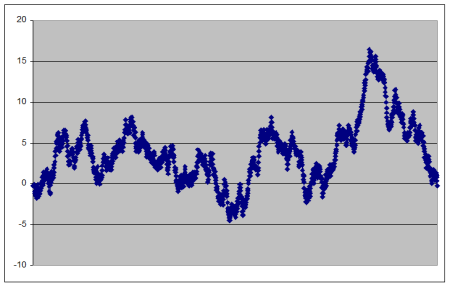
It still looks like it was drawn on blotting paper, but at least it shows what I needed to see in order for me to carry on possibly throwing money away playing poker at this level.
Good luck me?
I’m such a sucker for a tiered loyalty program.
The number of turbo sit-and-gos I play on Poker Stars each month tends to mean that I can just about retain SilverStar, and if I’m running a little short of points as the end of the month approaches I’ll make an effort to play a bit more in order to keep that precious status.
I don’t know why I bother really. I worked out the actual value of doing this is about $12 per month.
<show working>
The benefit of SilverStar (1500 base points per month) over BronzeStar (no qualification required) is that your FPPs (the points you can spend, not the VIP points that determine your status) accumulate 50% faster at the higher level. Once you have that level you keep it right through to the end of the following month.
So the difference between earning your first 1500 points in month as a BronzeStar player vs SilverStar is 750 FPPs. One FPP is worth about 1.6 cents, so those extra points are worth about $12.
</show working>
Like I said, I’m a sucker for it. But you know that without people like me these schemes just wouldn’t exist.
I do wish I hadn’t bothered going out of my way to keep my status at the end of last month though.
PokerStars are currently running an promotion where you get a bonus if you increase your VIP level this month.
If you upgrade from bronze to silver, you get $50, so if I’d actually dropped back to BronzeStar last month this would be an easy $50 for not really any more play than I’d usually put in. Much better than the $12 worth of player points from maintaining that level.
But now I need to bypass silver (1,500 points) and get to gold (4,000 points) for a $100 bonus.
It’s not even real money, it’s a bonus in your poker account that you then have to earn 7x the dollar amount in points to unlock. But the thing is, I just can’t say no.
$100 for free, and all I have to do is play about two and a half times as much as normal, and then make sure I play again next month too? Sure, sign me up.
Well, I started off thinking that’s how it was going to be, probably looking at 3-4 hours a day to stay on top of it, but Claire convinced me I should take the opportunity to move up levels (which will earn points twice as fast, so I don’t have to play for as long).
I was some way off the latest win goals I’d set myself before taking another shot at the next level, but in the absense of having the stats to back up a decision it does help to have someone to blame if it all goes wrong. 🙂 So I’m going to go for it.
I never wrote about what happened last time I tried this though.
Everyone loves a graph, and this one has even been annotated to add trend lines as I saw fit. You can even click on it for a high def version. You lucky, lucky people.
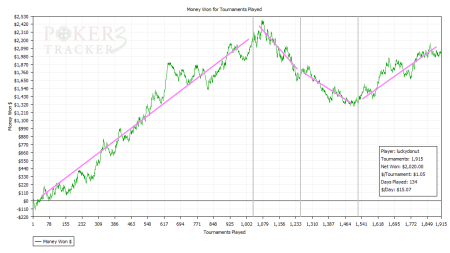
This is my entire PokerStars single-table SNG history for 2008 so far (apart from steps, which can’t be measured the same way).
I’ve marked four zones on the graph. Starting from the left, the first section is all $16 tournaments, and I was winning. Then I moved up to the $27s and crashed and burned. Next, I dropped back down to the $16s but played 6 at a time instead of the 4 I was used to, where I carried on losing – albeit slightly slower. Finally I dropped back down to 4-tabling and things seem to have settled back down to how they used to be.
I’d only given myself $500 to play with at the higher level, which lasted just over 200 tournaments. That isn’t really enough to know for sure whether I was getting killed by the game or I was just running bad. I’m still optimistic that it was the latter, but the downward trend seems pretty consistent after the initial spike.
The thing that really stands out when I look at those results is the number of times I cashed for the least possible money.
Overall I finished in the money almost as often as I did with the $16s (38% vs 40%) but on the $27s I had more 3rd place finishes than the total of my 1sts and 2nds put together! With 1st paying two and a half times as much as 3rd, that’s going to make quite a difference to my overall return, and I’ll need to watch closely this time around to try to see if there’s a reason I’m a habitual bronze medalist.
What surprised me most though was the difference between my results on the $16s when 6-tabling versus 4-tabling.
I really didn’t think I’d be giving up too much by playing two more tables – hoping, eventually, to be able to move up to 8 or more tables at a time and increase my volume before increasing my stake. I accepted I might not win as quickly if my concentration was being spread thinner, but I certainly didn’t expect to suddenly be losing money at the same rate I used to be winning it.
The reason I dropped right back to four $16s at a time was to see if I’d still got what it takes to beat that game. It’s not a huge sample size (which is why I was hesitant to move up just yet) but things seemed to change almost instantly. The graph appears to be going in the right direction and the last magenta line is virtually the same gradient as the first one.
So I don’t think I’m broken, but apparently four tables is as many as I can handle.
Anyway, the heat is on and the time is right for me to play my game. Going for gold, four-tabling the $27s. Watch this space.
|
|














Comments